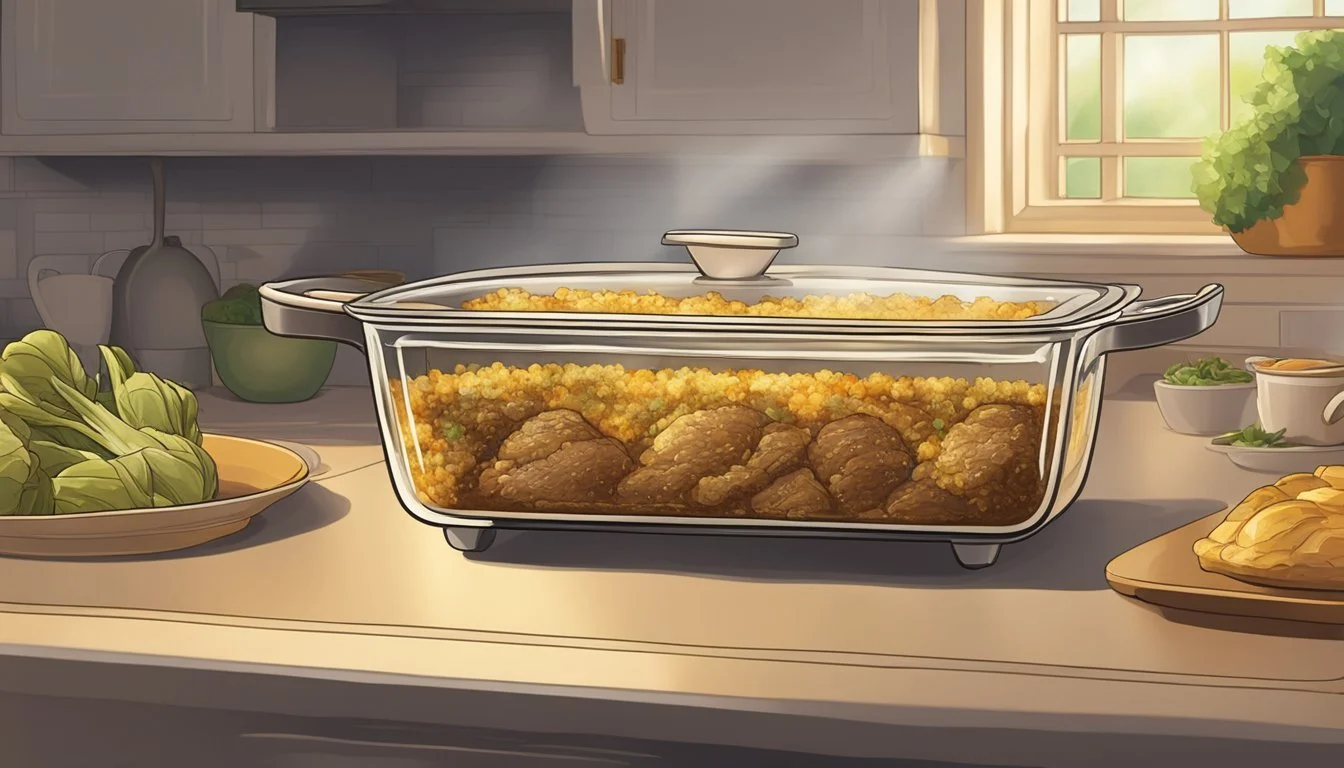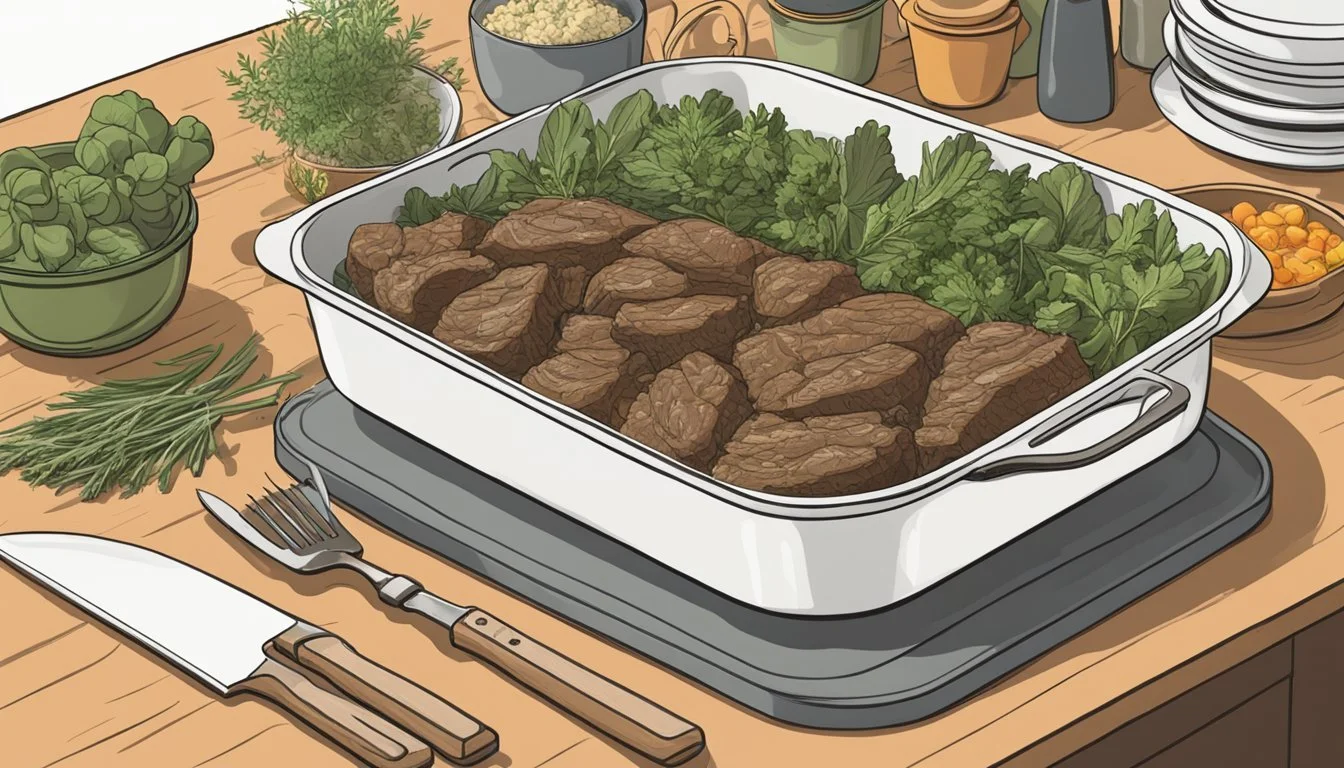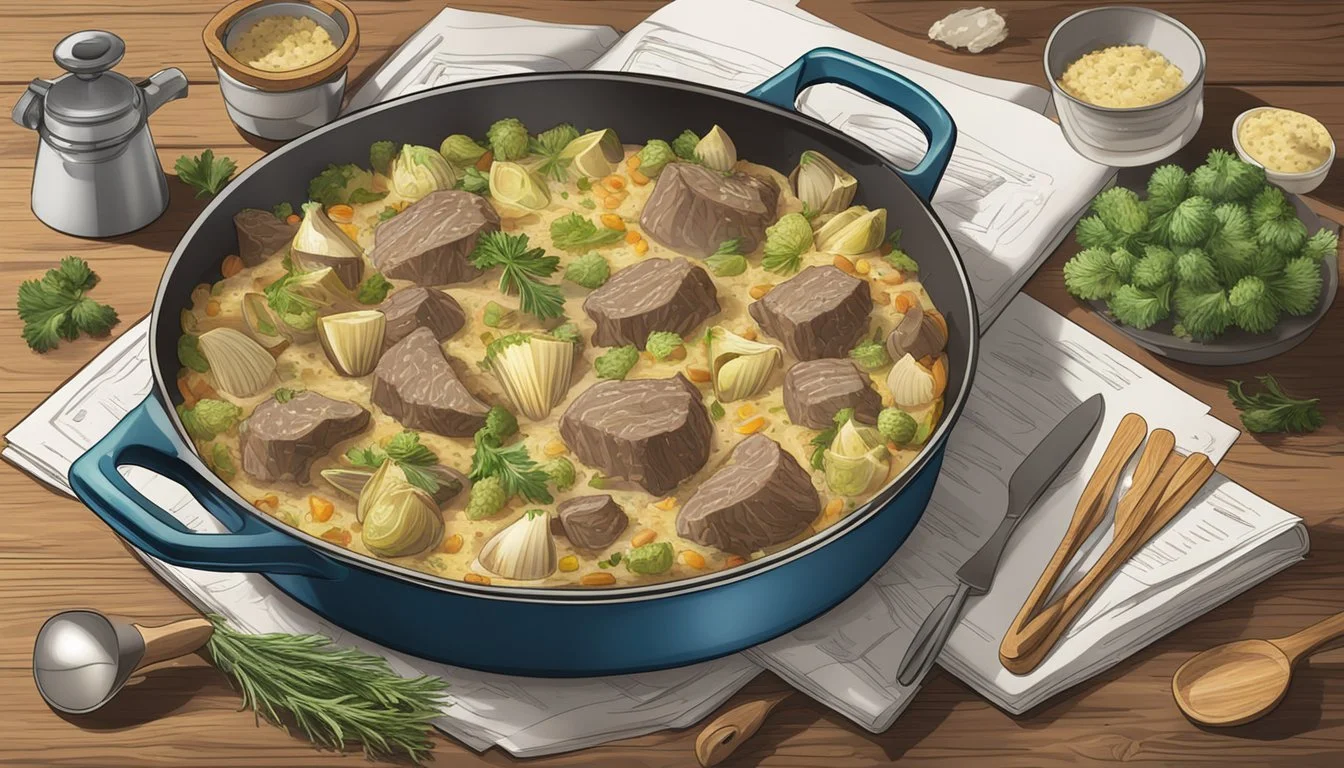How to Reheat Beef and Artichoke Casserole for Perfect Flavor
Reheating a beef and artichoke casserole can be straightforward and satisfying, ensuring that your leftovers taste just as delicious as the first serving. For the best results, preheat your oven to 350 degrees Fahrenheit, cover the casserole with aluminum foil to prevent drying, and bake for 20-30 minutes or until the internal temperature reaches 165 degrees Fahrenheit. This method helps retain the moisture and flavor of the casserole.
Alternatively, if you are short on time, the microwave offers a quicker option. Place the casserole in a microwave-safe dish, cover it with a moist paper towel and microwave in 1-minute intervals, stirring occasionally, until thoroughly heated.
Both methods ensure that your beef and artichoke casserole remains delicious and satisfying, making reheating leftovers a simple and effective process.
Essential Reheating Considerations
When reheating a beef and artichoke casserole, it is crucial to choose the best method, maintain proper temperature control, and ensure food safety. Below are key aspects to consider for optimal results.
Selecting the Right Reheating Method
Choosing the correct reheating method can greatly affect the texture and flavor of the casserole. Using an oven is often the best choice for a casserole, as it allows for even heating. Preheat the oven to 350°F (176°C), place the casserole in an oven-safe dish, cover with aluminum foil to retain moisture, and heat for about 20-25 minutes. Microwaving, while faster, can result in uneven heating. If using a microwave, heat on medium power in 1-2 minute intervals, stirring occasionally.
Understanding the Importance of Temperature Control
Proper temperature control ensures that the casserole is heated thoroughly without drying out or burning. Aim to reheat the food until it reaches 165°F (74°C) internally, as this temperature effectively kills any potential bacteria. Use a food thermometer to check this. Controlling the oven temperature by preheating to the suggested 350°F (176°C) will aid in steady and even cooking. If microwaving, turn the dish periodically to promote even heating.
Focusing on Food Safety
Food safety is paramount when reheating leftovers to prevent foodborne illnesses. Ensure the casserole has been stored correctly, either in the fridge if used within 3-4 days or the freezer for longer storage. When reheating, the food should move from the fridge or freezer directly into the oven or microwave without lingering at room temperature. If reheating from frozen, it’s advisable to thaw the dish in the fridge overnight to facilitate even reheating and reduce the risk of heating inconsistencies. Always discard any casserole that has been left out for more than two hours.
Preparing the Casserole for Reheating
To ensure your Beef and Artichoke Casserole retains its flavor and moisture while reheating, it's vital to follow these steps. Thawing the casserole, adding moisture, and covering it properly will help achieve the best results.
Thawing and Bringing to Room Temperature
Start by removing the casserole from the fridge. If it’s been frozen, allow it to thaw in the fridge overnight. Bringing the dish to room temperature before reheating can help it heat more evenly. Place the covered casserole on the counter for about 30 minutes before placing it in the oven.
Important: Avoid letting the dish sit out for too long to prevent bacterial growth.
Adding Moisture to Retain Flavor
To prevent the casserole from drying out, add a small amount of liquid. Use broth, water, or a drizzle of oil to maintain moisture. Spread the liquid evenly across the top.
Suggestion: Mix in the liquid gently if possible, to ensure it doesn't alter the casserole’s texture.
Covering Your Casserole Correctly
Use aluminum foil or plastic wrap to cover the casserole. This step is crucial to trap steam and maintain moisture. If using foil, make sure it’s crimped tightly around the edges of the dish. Check it halfway through reheating, removing the cover for the last 10 minutes if a crispy top is desired.
Tip: For a more eco-friendly option, reusable silicone lids can be considered.
The Reheating Process
Reheating beef and artichoke casserole can be done effectively using three primary methods: the oven, the microwave, and the stovetop. Each method has its own procedure to ensure the casserole is evenly heated, retains moisture, and does not dry out.
In the Oven
Preheat the oven to 350°F (175°C). Use a baking dish and cover the casserole with aluminum foil to prevent drying. Place the dish in the oven and heat for 20-30 minutes. Check the internal temperature with an instant-read thermometer. It should reach 165°F (74°C). If not properly heated, continue warming in 5-minute increments.
Don't overcrowd the oven, as this can impair heating efficiency. Make sure the oven rack is positioned in the middle to ensure even heat distribution.
In the Microwave
Place a portion of the casserole in a microwave-safe dish. Add a tablespoon of water or broth to maintain moisture. Cover with microwave-safe plastic wrap, leaving a small corner open for steam to escape. Heat on medium power for 2-3 minutes.
Stir occasionally for even heating. Check the temperature to reach 165°F (74°C) before serving. Avoid microwaving large portions at once to ensure uniform heating.
Stovetop Reheating Techniques
Begin by halving the artichoke lengthwise and placing them in a skillet. Add a small amount of oil or butter to the skillet to prevent sticking. Cover the skillet with a lid and maintain low to medium heat.
Turn the casserole pieces occasionally to ensure they are heated through evenly. Use a meat thermometer to ensure the beef reaches 165°F (74°C) before serving. Avoid using high heat as it can dry out the casserole.
Maximizing Flavor and Texture
To maximize the flavor and texture of your reheated beef and artichoke casserole, it is essential to focus on the right seasonings, achieving a crispy texture, and balancing the ingredients precisely.
Choosing the Right Seasonings
Using the appropriate seasonings can significantly enhance the flavor of your casserole. Salt and pepper are fundamental but consider adding garlic to bring out the savory notes. A mix of dried herbs like thyme or rosemary can add depth. For those who prefer a spicy kick, a dash of chili flakes can also work wonders.
Avoid over-seasoning, which can overpower the natural flavors of the beef and artichokes. A sprinkle of grated Parmesan cheese during reheating can add a delightful salty, nutty layer.
Achieving Crispiness
Crispiness can elevate the eating experience by adding a pleasing texture contrast. To achieve this, sprinkle a layer of breadcrumbs over the casserole before reheating. Use Panko breadcrumbs for an extra-crispy texture.
Preheat your oven to 350°F and cover the dish with aluminum foil, baking for about 20-25 minutes. Remove the foil in the last 5 minutes to allow the breadcrumbs to brown and become crispy. For an additional layer of flavor, lightly drizzle olive oil over the breadcrumbs before heating.
Balancing Ingredients
Balancing the ingredients ensures that every bite offers a harmonious blend of flavors. When reheating, make sure that the beef remains moist but not overly greasy. Adding a small amount of broth can help with this. The artichokes should be tender but not mushy.
Ensure an even distribution of ingredients throughout the dish. If the casserole appears dry, a small pat of butter or a drizzle of broth can revive its moisture content. Using a mixture of fresh and preserved ingredients can also boost the dish's overall appeal without overwhelming the palate.
Supplemental Tips for Best Results
To reheat Beef and Artichoke Casserole efficiently, it's important to consider the quantity of food and ensure even heat distribution. Following these methods will help maintain flavor and texture.
Adjusting Reheating Time for Quantity
When reheating large quantities of Beef and Artichoke Casserole, it's crucial to adjust the reheating time accordingly. Larger amounts of casserole will require longer reheating periods to ensure the center reaches the appropriate temperature.
Microwave: For smaller portions, start with 1-2 minutes, stirring midway to heat evenly. For larger portions, use 3-5 minute intervals, stirring frequently.
Oven: Preheat the oven to 350°F. A single serving typically needs 20 minutes. For a whole casserole, 30-40 minutes may be necessary. Cover with foil to prevent drying out.
Ensuring Even Heat Distribution
Proper heat distribution is essential to avoid cold spots and ensure the casserole is heated through.
Microwave: Cover the casserole with a microwave-safe lid or plastic wrap with vents. Stirring intermittently helps distribute heat more evenly.
Oven: Use a baking dish that allows the casserole to spread out in a thin layer. Cover the dish with foil, and stir halfway through the reheating process.
Air Fryer: If using an air fryer, avoid overcrowding. Reheat in batches if necessary. Place portions in a single layer to facilitate better airflow and even heating at 350°F for 10-15 minutes.
Post-Reheating Steps
After reheating a beef and artichoke casserole, there are essential steps to ensure the dish is perfectly presented and flavorful when served. These steps include resting the casserole and adding final touches for an enhanced taste.
Resting Before Serving
Once the beef and artichoke casserole has been reheated, it is crucial to let it rest for a few minutes before serving. This resting period allows the heat to distribute evenly throughout the dish, ensuring every bite is warm. Cover the casserole loosely with foil to retain heat without causing moisture build-up.
Resting also helps the juices to settle, which enhances the flavor and texture. Skipping this step can result in a dry or unevenly heated casserole. A 5-10 minute rest should be sufficient.
Final Touches and Garnishes
Adding garnishes elevates the presentation and taste of the casserole. Freshly chopped parsley not only adds a pop of color but also a light, refreshing flavor. A sprinkle of lemon juice just before serving can brighten the dish and counterbalance the richness.
For extra flair, consider adding a drizzle of melted butter or olive oil over the top. Black pepper or a pinch of sea salt can enhance the final taste. These finishing touches ensure the beef and artichoke casserole is as appealing to the eyes as it is to the palate.
Incorporating Reheated Casserole into Other Meals
Integrating leftover beef and artichoke casserole into new meals can elevate your dining experience and reduce waste. By turning the leftovers into versatile meal components, you can save time and maintain a balanced diet.
Casserole as a Meal Prep Component
Reheated casseroles are perfect for meal prep. Beef and artichoke casserole can be divided into portions and stored in airtight containers for easy lunches or dinners throughout the week. Pair these portions with a side of fresh vegetables or a salad for a complete meal. Additionally, combining the casserole with whole grains, such as quinoa or brown rice, can enhance its nutritional profile and keep you fuller for longer.
To add variety, consider mixing the casserole with a dollop of sour cream or Greek yogurt for a creamy texture. This not only adds flavor but also increases the protein content of your meal.
Creative Serving Suggestions
Use reheated beef and artichoke casserole as a unique topping for baked potatoes or sweet potatoes. Simply scoop the reheated casserole onto the baked potato and garnish with shredded cheese and chives for a hearty option.
For breakfast, add reheated casserole to a skillet with scrambled eggs. The mixture of beef, artichokes, and eggs provides a substantial protein boost to start the day right. Wrap the combination in a tortilla to create a delicious breakfast burrito.
Transform reheated casserole into a filling for bell peppers or zucchinis. Hollow out the vegetables, stuff them with the casserole, and bake until the vegetables are tender. This method not only repurposes leftovers but also adds an array of nutrients to your meal.
Utilize these approaches to make the most of your beef and artichoke casserole and enjoy diverse, flavorful meals.
Avoiding Common Mistakes
Reheating a beef and artichoke casserole can be tricky, but by avoiding a few common mistakes, you can maintain its delicious flavor and essential nutrients.
Preventing a Dry Casserole
Reheating can often dry out a casserole. To prevent this, cover the dish with aluminum foil or a lid to retain moisture. Adding a small amount of broth or water can also help. Baking the casserole at a moderate temperature of 350°F ensures even heating without losing moisture. Avoid using high temperatures as they can dry out the dish.
Sidestepping Flavor Loss
To keep the casserole flavorful, avoid overcooking during reheating. Limited reheating time at the correct temperature helps preserve its taste. Stir in some fresh herbs or add a little extra seasoning to enhance the flavors. Using a low and slow reheating method, such as an oven, enhances the natural taste of the beef and artichokes.
Minimizing Nutrient Waste
Nutrient retention is crucial, especially when dealing with vegetables and other nutrient-rich ingredients. Reheat only what you plan to eat to avoid repeated heating, which can reduce nutritional value. Covering the casserole during reheating also helps in conserving essential nutrients, particularly fibers in vegetables. Steaming or baking at lower temperatures can further preserve vitamins and minerals.
Additional Resources
For those who seek further insights into reheating beef and artichoke casseroles, a variety of websites, food blogs, and video tutorials can be incredibly helpful. Below are some curated resources covering these aspects.
Websites and Food Blogs
Many reputable websites and food blogs offer detailed guides on reheating casseroles. Allrecipes and Taste of Home provide step-by-step instructions, ensuring your dish remains moist and flavorful. Pinterest also hosts numerous pins with reheating tips and recipes that explore different casserole varieties.
For more niche advice, the Food Network's blog section includes chef-written articles focusing on preserving the texture and taste of your casserole. Additionally, Instagram can be a valuable resource, where chefs and home cooks share their tips and tricks through posts and stories, often accompanied by visual guides.
Video Tutorials
Watching a video tutorial can be particularly beneficial for understanding the nuances of reheating casseroles. Platforms like YouTube have countless tutorials from both amateur cooks and professional chefs. Channels such as Bon Appétit and Tasty offer high-quality videos that demonstrate precise techniques for maintaining the integrity of your dish.
Social media platforms like Facebook also feature short, informative videos. Groups dedicated to cooking often share their specialized methods for reheating various casseroles. Similarly, NSI (National Social Institutions) sometimes post detailed instructional videos on their pages, focusing on maintaining food safety and quality while reheating.





